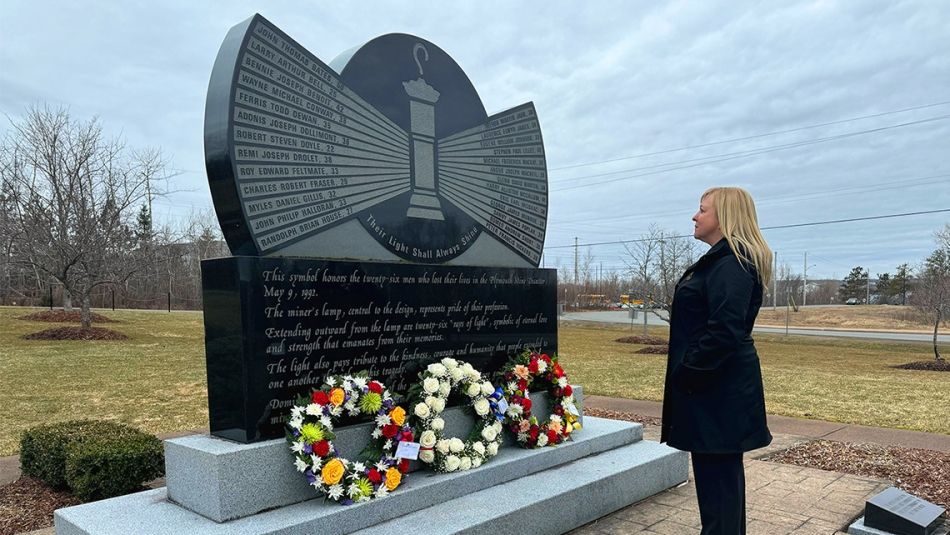
Share
Atlantic Regional Director Jennifer Murray pays respects to the 26 victims of the Westray Mine Disaster, at a March 26 service at Their Light Will Always Shine Memorial Park in New Glasgow, N.S.
20th Anniversary of the Westray Law
Unifor is marking the 20th anniversary of the Westray Law with a renewed call on regulators, police and government to avail of this law to bring those who grossly violate workplace health and safety to justice.
The law was enacted two decades ago on March 31st.
Those 2004 amendments to the Criminal Code of Canada made it possible to prosecute companies and individuals for criminal negligence in the cases of workplace death or bodily harm. The law was hailed as an important deterrent.
Unfortunately, the law must be exercised in order for it to be an effective deterrent and to date there have been few convictions since it was enacted. In the meantime, workplace fatality in Canada have not declined. There has not been enough use of them law by the police or by government, with only seven corporations and three individuals successfully prosecuted following workplace deaths.
Today and every day, we demand safer workplaces. We demand the Westray Law be used as a powerful tool in bringing those who fail to protect workers’ safety to justice.
Background on the Westray Mine Disaster
On May 9, 1992, 26 miners were tragically killed in the Westray Mine located in Pictou County, Nova Scotia, after a buildup of methane gas and coal dust ignited and caused an explosion underground in the mine. The explosion was so powerful that it was felt in the town of Plymouth, over a kilometer away.
The bodies of 15 of the 26 miners were recovered by the search and rescue teams. During the emergency efforts, the underground conditions worsened and put the search and rescue teams in grave danger which led to the decision to abandon the operation, entombing the bodies of 11 miners in the depths of the mine.
In the eight-month period after the mine opened and before the explosion, a number of health and safety problems had been raised to the employer, Curragh Resources, by employees, union officials, and government inspectors.
This disaster was a preventable one.
Public Inquiry and Charges Dropped
Not long after the tragedy, the Nova Scotia government ordered a public inquiry to investigate what caused one of the country’s deadliest mining disasters, and published the findings in late 1997. The findings stated that the mine was mismanaged, miners' safety concerns were ignored, and poor oversight by government regulators resulted in the disaster. Criminal charges were laid against two mine managers and the case proceeded to trial, but was ultimately dropped by the crown in 1998, as it was deemed that a conviction would be unlikely. Curragh Resources went bankrupt in 1993, but never faced direct repercussions for its role in the disaster.
The Westray Law
On March 31st, 2004, Bill C-45, known as The Westray Law, came into force. The Act amended the Criminal Code to establish the criminal liability of corporations and executives for workplace deaths and injuries.
Specifically, The Westray Law:
- established rules for attributing criminal liability to organizations, including corporations, for the acts of their representatives,
- established a legal duty for all persons directing the work of others to take reasonable steps to ensure the safety of workers and the public,
- set out factors that a court must consider when sentencing an organization,
- and, provided conditions of probation that a court may impose on an organization.
The Westray Law established an occupational health and safety duty for all organizations and individuals who direct the work of others in Canadian organizations and workplaces. It requires all organizations and individuals who undertake or have the authority to direct how others work or perform a task, to take all reasonable steps to prevent bodily harm to the person performing the work or task, and to any other person. In other words, if your directives were a careless or reckless breach of legal duties, you or your organization could face criminal punishment. If you were directing work that was breaking a law or regulation – you and your organization could be charged criminally.
The financial penalties for those found guilty of offenses under the Westray Law are also different and potentially much more severe than those in provincial or federal jurisdictional health and safety regulations. A conviction under the Criminal Code may lead to greater penalties for all involved, with deeper repercussions. Also, being charged criminally is much more damaging from a public and reputational perspective.
It took years of intense activism by the labour movement to amend the Criminal Code. Today, we must continue to press for its application in workplace deaths and injuries.
Police must work in a co-ordinated manner with Crown Prosecutors and Safety Regulators to create a harmonized approach between stakeholders to have more employers charged when they choose profit over health and safety.
Canada should follow the United Kingdom’s lead, where worker fatality rates have decreased significantly. The UK has a similar law called the Corporate Manslaughter and Corporate Homicide Act which was enacted in 2007 and similarly increased pressure to affect the behaviour of senior corporate decision-makers to protect workers from serious injury or death associated with poor workplace safety compliance and management. The UK’s statistical fatality rates are almost half of what they used to be since this law was enacted.
We need to see the same results in Canada. Workers deserve to be safe at work. Full stop.
For more information contact the Health, Safety and Environment Department at healthandsafety@unifor.org
In Solidarity,
Jennifer Murray
Atlantic Regional Director


